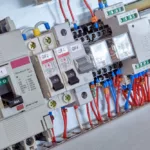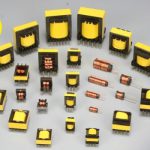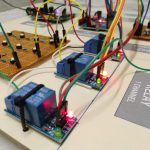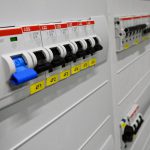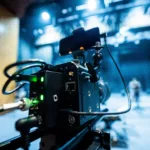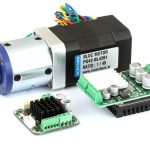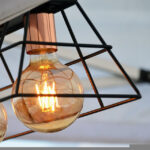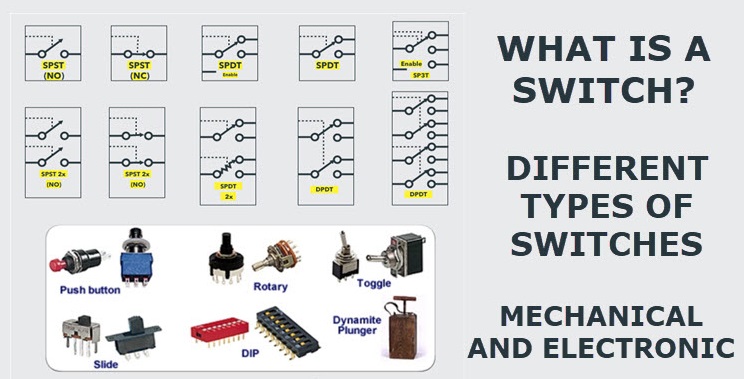
Electrical Switches:
Electrical Switches are electrical components that can either connect or disconnect the guiding route in which electrons flow in an electrical circuit. Switches are manufactured in various structures, e.g., they might have multiple sets of connections managed by a single actuator or button. In electrical engineering, an electrical switch is anything that diverts or interrupts the electric current from one electrode to another. Switches are devices that are used to power on or off daily used equipment such as fans, lights, water pumps, computers, TVs, and other electrical machines. When the switch is on the circuit is closed and the current will flow to power up the device (turn on the device). When the switch is off that means the circuit is open and the current will not flow.
An electric switch can be operated physically, for instance, a keyboard button or a light bulb switch. Switches may also function as a sensing device that can sense the state of a machine’s part like temperature, liquid level, or pressure, and manage the machine automatically such as a thermostat.
Different Types of Electrical Switches:
Primarily there are two different types of switches, “Electrical Switches’ ‘ and “Mechanical switches’ ‘, both types of switches are used in electrical circuitry depending on their functionality and requirements. The Different types of electrical switches as well as mechanical switches are illustrated below:
Electrical Switches- These electric switches types are self-propelled switches that include:
- Diode for alternating current (DIAC)
- Power Diode
- Bipolar Transistors
- Insulated-gate bipolar transistor (IGBT)
- Gate turn-off Thyristor
- Triode for alternating current (TRIAC)
- Selective Catalytic Reduction (SCR)
- metal-oxide-semiconductor field-effect transistor (MOSFET)
Mechanical Switches- Mechanical switches are those types of switches that are controlled manually, types of these switches are.
- Single-pole-single-throw (SPST)- SPST is a switch type that simply has one input terminal known as the pole and a single output terminal called throw.
- Single-pole-double-throw (SPDT)- These switches have a single input terminal (one pole) and two output terminals (two throws) that act as a selector switch between loops.
- Double-pole-single-throw (DPST)- These switches can control two circuits simultaneously because they have two input terminals (poles) and two output terminals (throws).
- Double-pole-double-throw (DPDT)- This has six terminals, two for each of the two input terminals (poles) and the four output terminals (throw). In these switches, two input terminals are connected to one pair of output (throw) (pole).
- Two-pole-six-throws (TPST)- TPST has a single input terminal (pole) and six output terminals (throws) for every pole, which means they have total output terminals.
- Momentary control switches- These mechanical switches are further divided into subclasses, such as:
- Rotary Switches- Rotary switches are used in channel, range, or band selectors. These switches connect one line among many lines.
- Temperature switches- These switches comprise resistance temperature components that sense temperature and manage it according to the given value of temperature.
- Pressure Switches- Pressure switches are used to boost or reduce pressure from a set point.
- Toggle Switches- These switches have a lever that is moved up and down for power On or Off and are particularly used in home appliances.
- Push-button- The circuit gets closed for electric current to flow when the push button is pressed. The flow of current stops when the pressure on the push button is released.
Differences among Industrial, Commercial, and Domestic Switches:
Switches Used in Industrial & Commercial Areas- Two-pole-six-throws (TPSTs), and double-pole-double-throws (DPDTs) are the electrical switches types, commonly used in commercial areas. While, Rackmount switches, DIN rail, and wall mount switches are specially manufactured types of electrical switches suitable for high voltage regulation in large industries. Furthermore, push-button manual switches are different electric switches types that can be frequently seen in big industrial settings.
Switches used in Domestic and Home Applications- Single pole, two-way, and three-way switches, and simple rocker switches are the types of electric switches used in home applications for the purpose of turning ON or OFF any domestic or homely electrical device. Additionally, bell push switches are established in homes, offices, and other domestic premises. A bell push switch is an always retains a shattered circuit until the button is pressed to close the circuit.
Manufacturers of Electrical Switches:
We provide different types of electric switches from the world’s highly reputed brands like:
- Apem
- Arcol
- Arcolectric (Bulgin) Ltd
- Bourns
- Clipsal Electrical
- Eaton
Material Used for Making Switches:
Switches in this modern era are made up of thermosetting plastic which basically is a polymer. Although before thermosetting plastic, most of the switches were made of porcelain, then later on these switches were manufactured from formaldehyde and phenol which was the most recent and significantly popular material used in many different electric switches types.
Basic Working Principles of Switches:
Switches are basically binary components; they are either completely ON or OFF. Electric Switches have a very simple layout. Electrical switches are devices that disconnect the flow of current in a circuit. The basic working principle of an electrical switch is to maintain the current between the source power and the load. When the switch is OFF the circuit is broken and the flow of current is stopped. The voltage is the amount of pressure or force employed by the power source, while the power source is the electrons that drive all the way through the circuit.
Types of Switches that Enrgtech Supplies:
Enrgtech houses a wide variety of electrical switches of different types that are listed below:
- Double Pole Double Throw (DPDT)
- Double Pole Single Throw (DPST)
- Normally open (NO)
- Single-pole-change-over (SP-CO)
- Single-pole-double-throw (SPDT)
- Single-pole-normally-open (SPNO)
- Single-pole-single-throw (SPST)
- Single Pole Double Throw (SPDT)
- Single Pole Single Throw (SPST)






